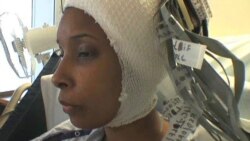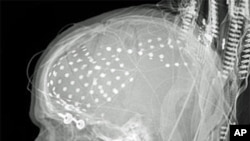From VOA Learning English, this is Science in the News. I'm Steve Ember.
And I'm Jim Tedder. Today we will tell about the brain disorder known as epilepsy. Many people do not understand epilepsy. Medical experts are working to understand it and improve the lives of those who suffer from it. There is no cure for epilepsy. But we will tell you about new treatments for the disorder.
Epilepsy is a medical condition that produces seizures. A seizure happens when a sudden increase of electrical activity interferes with normal operations in the brain.
Nerve cells use electrical particles to communicate with each other. Millions of electrical particles pass between nerve cells in the brain. When the brain has a sudden burst of electricity, the body experiences physical changes called epileptic seizures. Victims can shake uncontrollably for brief periods. They also can temporarily lose the ability to think clearly or communicate.
Most seizures can last anywhere between 30 seconds and two minutes. These seizures do not cause permanent damage. However, a seizure is considered a medical emergency if it lasts more than five minutes. One in 10 adults will have a seizure during their life.
Different kinds of seizures result when different parts of the brain are affected. If electrical activity increases in only one area of the brain, the person has what doctors call a partial seizure. Many times, people may suffer a partial seizure and do not know it. They might note strange feelings in an arm or leg. They also might hear noises or look straight ahead for a few minutes.
Sometimes the individual will have an uncontrolled movement, like turning the head to one side. Most partial seizures last less than 90 seconds. So it is not always possible for others to recognize them as signs of a disorder.
When people hear the word seizure, they often think of what doctors call a grand mal seizure. A person experiencing this kind of seizure will fall to the ground. His or her body will become firm and start to shake. After a few minutes, the individual will stop moving and go into a deep sleep, one that may last an hour or more. When they re-awaken, they will not remember what just happened. Some grand mal seizures start with partial seizures and become worse.
Experts have reported different reasons why an individual may suffer epileptic seizures. For example, older adults may develop epilepsy because of an infection, stroke, or Alzheimer's disease. Head injuries or a lack of oxygen at birth may damage the electrical system in the brain. Other causes are poisoning and high body temperatures.
The World Health Organization estimates that about 50 million people around the world have epilepsy. The WHO says the highest number of cases are in developing countries. It says many people in the developing world suffer from epilepsy because of local conditions. In such areas, people have a greater chance of experiencing a medical condition or disease that can lead to permanent brain damage.
The World Health Organization says many people with epilepsy receive no treatment. And for those who do receive treatment, a medical operation may be too costly.
There is no cure for epilepsy. Generally, medicine is used to treat patients with the disorder. The Epilepsy Foundation of America says different kinds of medicines can stop or control different kinds of seizures.
There are many different kinds of anti-epileptic medicines on the market. These drugs work best only after they reach what experts call a desired level in the body. It might take months to identify the right drug to control the disorder because each one may cause side effects. These include weight gain or loss, eye or stomach problems, sleepiness and loss of balance. Some people may suffer depression, or have problems thinking or talking after taking some drugs. And the WHO says anti-epileptic drugs work only 70 percent of the time.
Some people with epilepsy may be able to control their seizures by controlling what they eat. The ketogenic diet was developed in the first part of the 20th century. It is very high in fat and low in carbohydrates. It makes the body burn fat for energy instead of sugar.
This diet requires family cooperation if the patient is a child. It also requires trained medical supervision. The patient must be in a hospital for the first part of the treatment. The amount of food and liquid the patient can have at meal time must be carefully weighed for each individual. The patient should obey the dietary restrictions for at least one month before experts know if the treatment is successful.
The Epilepsy Foundation says that about one third of children on the ketogenic diet become seizure-free or almost seizure-free. Another third improve but still experience some seizures. The others cannot continue with the diet or it has no effect on their seizures.
Possible effects of the diet include digestive problems, loss of fluids in the body, and development of kidney stones or gall stones. Another danger is that high levels of fat could develop in the blood.
Last year, doctors in Taiwan reported that the ketogenic diet was effective in reducing seizures in children with epilepsy. The doctors are pediatricians, specialists in treating children, at the Chang Gung Memorial Hospital. They examined children who stayed on the diet for more than a year. The pediatricians said more than half of the children experienced a 50 percent reduction in seizures. In fact, 64 percent reportedly became seizure-free with the diet!
Medical researchers continue searching for better ways to treat epilepsy. Every year, the American Epilepsy Society holds a meeting to discuss new findings and ideas about the disorder. In December of 2013, more than 4,800 people attended the conference in Washington, DC.
Researchers from the Emory University School of Medicine presented a study about a treatment called Stereotactic Laser Ablation, or SLA. The procedure has been proven to help control seizures in people suffering from extreme epilepsy.
SLA is a surgical operation aimed at preventing seizures. It is different from traditional epileptic surgeries because it protects more areas of the brain.
Traditional surgery requires large cuts through different parts of the brain. The cuts can result in severe memory loss. But SLA is done with a laser. And the researchers say it has prevented memory loss. Patients have a faster recovery time because the surgery is completed using lasers.
The Food and Drug Administration recently approved another treatment for epilepsy. It is called the NeuroPace RNS system. It was created to treat partial epilepsy through preventative measures. The manufacturer, NeuroPace, says the device is designed for use in patients aged 18 years and older.
Doctors surgically place the RNS system inside the brain of the patient. It operates on battery power. The RNS system can produce a short series of electrical bursts to the brain. The device is programmed to look for electrical activity in the brain that would interfere with normal operations. If the system identifies a problem, it produces bursts of electricity to normalize the brain before a seizure takes place.
The system uses a software program in a computer to communicate with the implanted RNS system. The program is also able to study the patient's brain activity.
NeuroPace completed its first experiments with the RNS system in 2004. The company has been testing the device since then. The Food and Drug Administration approved the system for public use late last year.
Another form of surgery is Vagus Nerve Stimulation. The FDA approved the treatment in 1997. It is designed for adults and young people who have partial seizures that cannot be controlled in other ways.
In this treatment, electrical energy enters the brain through the vagus nerve in the neck. The electricity comes from a small battery placed under the skin in the chest. Medical experts set the device to provide a small amount of energy every few minutes. The patient can also send a few seconds of energy through the nerve if he or she feels that a seizure is near. This has been known to stop a seizure.
The Epilepsy Foundation says people using Vagus Nerve Stimulation still must take anti-seizure medicines. But the amount may decrease as the treatment continues.
Doctors can also operate to remove the part of the brain suspected of causing epileptic seizures. This is done only when medicines fail to control the disorder.
This Science in the News was written by Brianna Blake and Kim Varzi. I’m Steve Ember.
And I’m Jim Tedder. Listen again next week for more news about science on the Voice of America.
We are sorry, but this feature is currently not available







